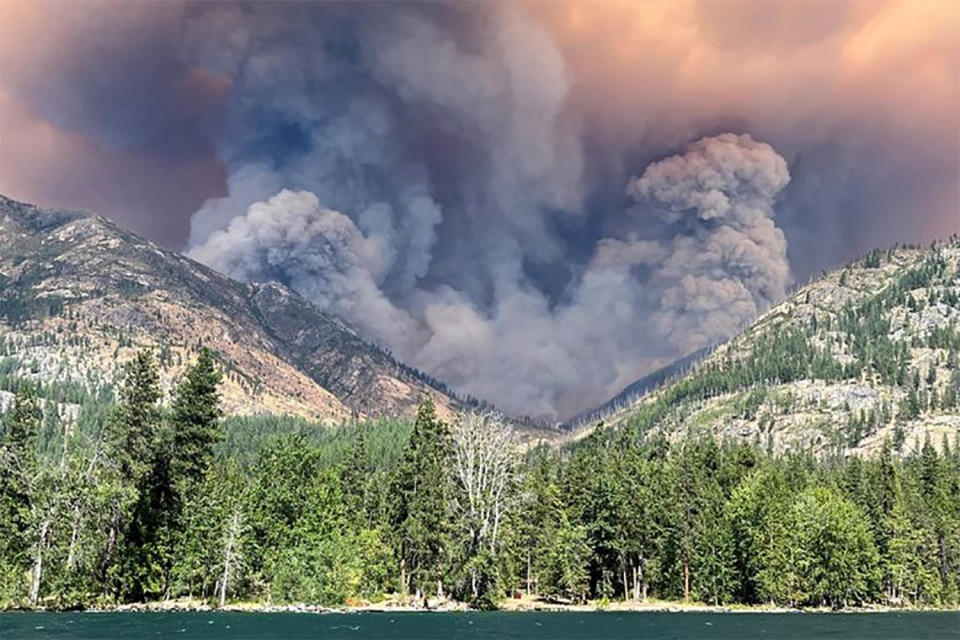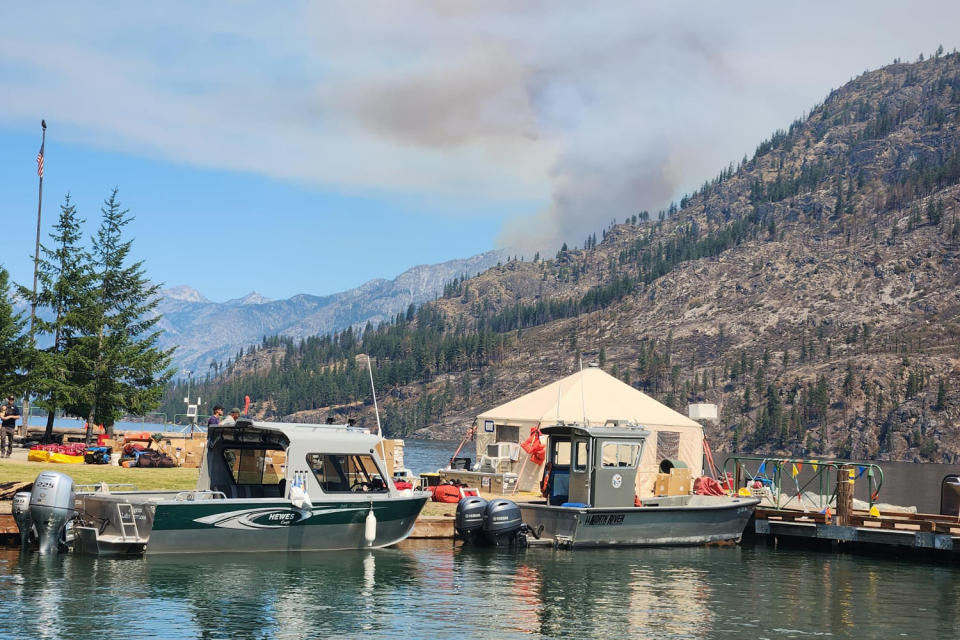SEATTLE — As the Pioneer Fire raged within a mile of the remote northern Washington town of Stehekin, emergency management officials ran door to door Sunday, urging residents to leave.
The evacuation alert was raised to the highest level.
“The boats are working,” said Chelan County Emergency Management Specialist Rich Magnussen. “They are running twice a day to try to get people out who choose to leave.”
There weren’t many takers. Most residents remained in their homes, choosing to reinforce their defenses and provide support to firefighters rather than flee.
“We will do everything we can to get people out, but due to the conditions of the fire, we cannot guarantee,” Magnussen added.
Stehekin is a tight-knit community on the shores of Lake Chelan, a 50-mile deep lake that winds through the North Cascade Mountains – one of the most rugged landscapes in the US. No roads connect Stehekin to the rest of the state. The only quick exit is by helicopter or boat.
“We really need these people to get downriver and out of harm’s way,” Washington Gov. Jay Inslee said in a statement. video address in Xbegging residents to evacuate.
But by Wednesday afternoon, three days later, 90 of the area’s 95 residents had decided to stay where they were, according to Magnussen, who said Washington residents have a legal right to stay and defend their homes during a wildfire. .
Chelsea Courtney, a Stehekin resident and artist who works at the local bakery, chose to stay.
“There are a lot of really independent people here who are used to being extremely resourceful and trusting their neighbors,” Courtney said. “People care passionately about this valley and the lives they’ve built here and I don’t think we fully trust the entities with the management choices that have happened.”
Courtney said Stehekin residents appreciate the firefighters’ efforts, but also question why the fire couldn’t have been attacked more aggressively when it started in June. She added that there have been occasional miscommunications between firefighters and residents, and she doesn’t understand why more couldn’t have been done in the colder months to manage the forest to better adapt to climate change.
Mistaya Johnston, a local paramedic and ranch resort owner, added, “There are a lot of people here who just don’t have the confidence,” and in such a self-sufficient community, a lot of people want to see it for themselves when the stakes are so high. high.
“If our business burns down, we will no longer receive a salary,” Johnston said.

Feelings like these are common during high-stress wildfires across the rural West. As large, intense wildfires and evacuations become more common, some residents are increasingly tired of uprooting their lives and are increasingly inured to the risk – or more confident in their own abilities to manage it themselves. .
This means that some people are determined to stay in their homes even when authorities say they must leave, especially when there are divergences of trust between communities and those managing wildfires and emergency response.
“Especially in rural communities, we’re starting to see a lot more people decide to stay and defend,” said Amanda Stasiewicz, an assistant professor of environmental studies at the University of Oregon who studies evacuation decisions. “There’s a lot of distrust going on there.”
As fire behavior intensifies due to climate change and excessive forest growth, doubts may worsen in rural communities as fire managers operate more conservatively than in the past.
“People were used to seeing fires attacked in different ways for decades and now the reality is different,” said Stasiewicz. “Now we are seeing fires act more radically, creating their own climate and being more unpredictable.”
This dynamic is occurring in rural communities elsewhere.
Some Northern California residents whose homes are threatened by the Park fire — now at more than 397,000 acres and the fourth largest in state history as of Friday morning — have similarly decided not to evacuate, the San Francisco Chronicle reported. One couple told the Chronicle they soured on evacuation after having to wait 10 days to return home following the 2018 bonfire.
Some 94 major fires are burning across the West, which more than 29,000 wildland firefighters are working to suppress, according to the National Interagency Fire Center. Of those fires, 28 have active evacuation orders.
“When things get like this, everyone is working and resources are running out,” said Brad Bramlett, public information officer assigned to Pioneer Fire.
The Pacific Northwest in particular is suffering this summer, with an estimated 51 large fires burning across Oregon, Washington and Idaho. A hotter and drier than normal spring and summer primed the landscape to burn.
As of Friday morning, the Stehekin area was under a red flag warning for fire dangerous weatheraccording to the National Weather Service. The Pioneer Fire has grown to more than 33,700 acres and was about 12% contained.
Most years, fire season has just begun.
Stehekin’s full-time population is about 85, and its residents take small-town life to the extreme. The community resisted telephone service in the early 2000s.
Surrounded by glacial peaks and the crystal clear waters of Lake Chelan, the town swells in population during the summer as tourists take 2.5-hour ferry rides to access trails in North Cascades National Park that begin in Stehekin.
The Pioneer Fire began on June 8 and has been slowly creeping north. It’s burning in some of the most challenging terrain firefighters face in the U.S., with steep slopes, rocky outcrops and few trails.
“As soon as I heard about it, I was like, ‘OK, let’s do it,’” Courtney said. “We all know how dry and early spring has been. It looked like the fire season would be accelerated.”
Stehekin residents have been planning and preparing, Courtney said, removing bushes near homes, building a floating dock in the harbor and holding community meetings.
Tourists were forced to flee the country on July 25 when emergency authorities raised the evacuation level to 2 from 3.
Meanwhile, firefighters flooded Stehekin. More than 640 firefighters are working the fire, although not all are based in the city. Johnston said she and her team of six served about 200 meals a day to the crews.
On Sunday, emergency authorities asked everyone in the city to leave.
Magnussen said emergency management authorities cannot guarantee any kind of help, especially if the boat dock — “the only way out,” as he described it — burns down.
“When they decide to stay, they do so at their own risk,” he said.
Courtney said she recognizes that, but worries that leaving Stehekin now could mean she won’t be able to return for weeks, if not longer. She feels that her self-sufficient community, full of people who have boats and are used to working the land, is prepared to defend itself from the fire, for now.
Some previous incidents also hardened his attitude towards fire. Courtney witnessed the 2015 Wolverine Fire, which burned more than 60,000 acres near Stehekin, and last month, she joined family and friends a few miles “down the lake” to save her uncle’s property after firefighters left.
“My tolerance has increased,” she said.
Stasiewicz said that, based on her own focus groups, surveys and interviews, feelings like Courtney’s are becoming more common in rural communities. Evacuation often comes at a high financial cost, she said, and some rural residents fear their properties will not be prioritized.
“Sometimes we can see rural communities lose out compared to more developed areas. There’s this mentality: ‘Maybe we have to take care of ourselves,’” Stasiewicz said.


Plus, she added, longer fire seasons with more frequent burns are wearing people down.
“If I’m told to evacuate every summer and they all fail, there’s this ‘crying wolf effect,’” Stasiewicz said. “You lose trust in the experts who say you need to evacuate.”
For authorities, these trends mean that it is increasingly difficult to convince people to leave. At the same time, fire managers are dealing with more dramatic fire behavior, which may lead them to make more conservative decisions – including issuing more frequent and widespread evacuation warnings.
In Stehekin, residents and firefighting crews cut containment lines along the eastern outskirts of town and installed sprinkler systems fed by the lake.
Planes and helicopters have been collecting water from Lake Chelan and dumping it on the fire.
Courtney said incident management teams have been rotating shifts; the most recent group was more communicative and proactive. She has been helping to feed the firefighters every day at Stehekin Pastry Co..
Courtney said Stehekin’s future will depend on the intensity of the fire, the strength of the containment line and whether the wind will push the fire into town.
And what happens if the fire reaches the city?
“I have access to a boat,” she said.
This article was originally published in NBCNews. with


































/cdn.vox-cdn.com/uploads/chorus_asset/file/23932741/acastro_STK070__03.jpg?w=150&resize=150,150&ssl=1)